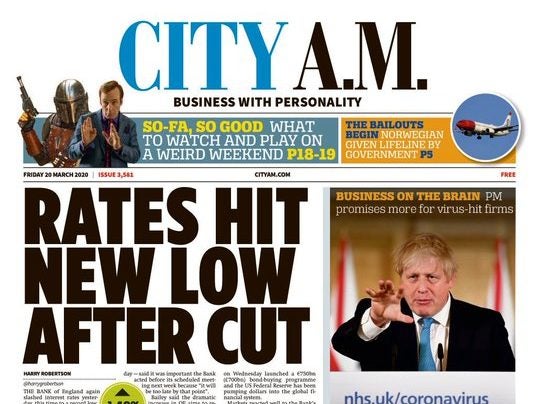
City AM has pushed its return to print back by about a month as commuters have proved slower than expected to return to offices.
The free daily business newspaper put its print edition on hold on 20 March and later put plans in place to return on Monday 7 September.
It is now delaying until an unspecified date in early October as advertisers are understood to be delaying campaigns to grab commuters once more have returned to London’s streets.
Before the pandemic hit, City AM was distributing about 85,000 copies each day.
Chief executive Jens Torpe said: “We have postponed our return to print by a few weeks, just to reflect the fact that commuter numbers – though increasing at speed – are not quite at the point where we are ready to turn the presses back on and be assured of a reliable daily audience for the print product.
“We look forward to being back in print at the start of October when we fully expect greater numbers of readers passing through stations and more certainty in the advertising market.
“September marks the paper’s 15th birthday and we are entirely confident that after returning to print in October we will celebrate many more milestones in the future.”
According to the Guardian, Tube passenger numbers were 72% below pre-Covid levels for Tuesday’s morning rush hour, while bus usage was down 53% from 2019.
Torpe told staff in an email it would therefore be “totally irresponsible” to return to print on Monday as this could lead to a “huge financial loss”.
City AM has avoided redundancies by making use of the Government’s job retention scheme. Press Gazette understands that staff had begun to return from furlough ahead of Monday’s planned paper and that some will now be put back onto the scheme temporarily.
Staff did take pay cuts but a return from 80% to 90% salary in September will still go ahead, although the 90% level will now remain into October.
The website, which has grown its traffic by 25% year-on-year since the pandemic began, will continue with a full reporting team over the next month.
City AM, along with the Metro and Evening Standard, depends on commuters to pick up its free print edition and get eyeballs to its advertisers.
The Metro kept publishing throughout the crisis, targeting key workers who continued to travel even as most stayed home during the strictest months of lockdown. It cut its distribution from 1.4m in February to 398,787 in April.
The Evening Standard delivered to homes in London for the first time in its history but also cut its distribution from 800,000 copies a day to 423,285 in April.
Free magazine Time Out’s chief executive Julio Bruno has told Press Gazette he is seeing “more and more” interest from advertisers and is optimistic a return to weekly production will soon be sustainable.
Many journalists are among those continuing to work from home as newsrooms consider introducing more flexible working into their practices on a permanent basis.
The Confederation of British Industry boss Carolyn Fairbairn warned in the Daily Mail last week that UK cities were looking like “ghost towns missing the usual bustle of passing trade”.
Email pged@pressgazette.co.uk to point out mistakes, provide story tips or send in a letter for publication on our "Letters Page" blog
